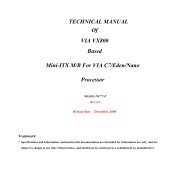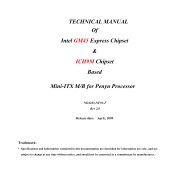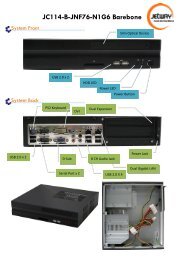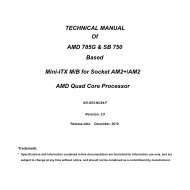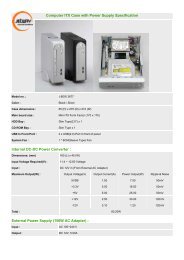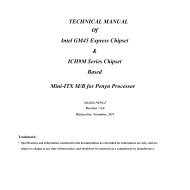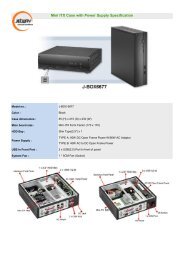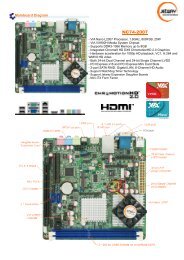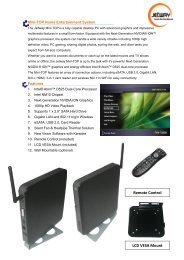Connectors - Jetway Computer
Connectors - Jetway Computer
Connectors - Jetway Computer
Create successful ePaper yourself
Turn your PDF publications into a flip-book with our unique Google optimized e-Paper software.
TECHNICAL MANUAL<br />
Of<br />
Intel 945GSE Express Chipset<br />
&<br />
Intel FW82801GBM ICH Chipset<br />
Based<br />
Mini-ITX M/B for ATOM Processor<br />
NO.G03-NF95A-F<br />
Revision: 3.0<br />
Release date: March, 2011<br />
Trademark:<br />
* Specifications and Information contained in this documentation are furnished for information use only, and are<br />
subject to change at any time without notice, and should not be construed as a commitment by manufacturer.
Environmental Protection Announcement<br />
Do not dispose this electronic device into the trash while discarding. To minimize<br />
pollution and ensure environment protection of mother earth, please recycle.<br />
ii
TABLE OF CONTENT<br />
ENVIRONMENTAL SAFETY INSTRUCTION...........................................................................iv<br />
USER’S NOTICE .......................................................................................................................v<br />
MANUAL REVISION INFORMATION.......................................................................................v<br />
ITEM CHECKLIST .....................................................................................................................v<br />
CHAPTER 1 INTRODUCTION OF THE MOTHERBOARD<br />
1-1 FEATURE OF MOTHERBOARD................................................................................1<br />
1-2 SPECIFICATION .........................................................................................................2<br />
1-3 LAYOUT DIAGRAM....................................................................................................3<br />
CHAPTER 2 HARDWARE INSTALLATION<br />
2-1 JUMPER SETTING .....................................................................................................6<br />
2-2 CONNECTORS AND HEADERS................................................................................10<br />
2-2-1 CONNECTORS .............................................................................................10<br />
2-2-2 HEADERS .....................................................................................................11<br />
CHAPTER 3<br />
3-1 ENTERNING SETUP...................................................................................................19<br />
3-2 GETTING HELP ..........................................................................................................19<br />
3-3 THE MAIN MENU........................................................................................................19<br />
3-4 STANDARD CMOS FEATURES ................................................................................21<br />
3-5 ADVANCED BIOS FEATURES ..................................................................................23<br />
3-5-1 CPU FEATURES.............................................................................................25<br />
3-6 ADVANCED CHIPSET FEATURES ...........................................................................26<br />
3-7 INTEGRATED PHERIPHRALS ..................................................................................28<br />
3-7-1 ONBOARD IDE FUNCTION ............................................................................29<br />
3-7-2 ONBOARD DEVICE FUNCTION.....................................................................30<br />
3-7-3 ONBOARD SUPERIO FUNCTION..................................................................31<br />
3-8 POWER MANAGEMENT SETUP...............................................................................33<br />
3-9 PNP/PCI CONFIGURATION.......................................................................................35<br />
3-10 PC HEALTH STATUS.................................................................................................36<br />
3-11 MISCELLANEOUS CONTROL...................................................................................37<br />
3-12 PASSWORD SETTING ...............................................................................................38<br />
iii
3-13 LOAD STANDARD/OPTIMIZED DEFAULTS ............................................................39<br />
Environmental Safety Instruction<br />
• Avoid the dusty, humidity and temperature extremes. Do not place the product in<br />
any area where it may become wet.<br />
• 0 to 60 centigrade is the suitable temperature. (The figure comes from the request<br />
of the main chipset)<br />
• Generally speaking, dramatic changes in temperature may lead to contact<br />
malfunction and crackles due to constant thermal expansion and contraction from<br />
the welding spots’ that connect components and PCB. <strong>Computer</strong> should go<br />
through an adaptive phase before it boots when it is moved from a cold<br />
environment to a warmer one to avoid condensation phenomenon. These water<br />
drops attached on PCB or the surface of the components can bring about<br />
phenomena as minor as computer instability resulted from corrosion and oxidation<br />
from components and PCB or as major as short circuit that can burn the<br />
components. Suggest starting the computer until the temperature goes up.<br />
• The increasing temperature of the capacitor may decrease the life of computer.<br />
Using the close case may decrease the life of other device because the higher<br />
temperature in the inner of the case.<br />
• Attention to the heat sink when you over-clocking. The higher temperature may<br />
decrease the life of the device and burned the capacitor.<br />
iv
USER’S NOTICE<br />
COPYRIGHT OF THIS MANUAL BELONGS TO THE MANUFACTURER. NO PART OF THIS MANUAL,<br />
INCLUDING THE PRODUCTS AND SOFTWARE DESCRIBED IN IT MAY BE REPRODUCED, TRANSMITTED<br />
OR TRANSLATED INTO ANY LANGUAGE IN ANY FORM OR BY ANY MEANS WITHOUT WRITTEN<br />
PERMISSION OF THE MANUFACTURER.<br />
THIS MANUAL CONTAINS ALL INFORMATION REQUIRED TO USE THIS MOTHER-BOARD SERIES AND WE<br />
DO ASSURE THIS MANUAL MEETS USER’S REQUIREMENT BUT WILL CHANGE, CORRECT ANY TIME<br />
WITHOUT NOTICE. MANUFACTURER PROVIDES THIS MANUAL “AS IS” WITHOUT WARRANTY OF ANY<br />
KIND, AND WILL NOT BE LIABLE FOR ANY INDIRECT, SPECIAL, INCIDENTIAL OR CONSEQUENTIAL<br />
DAMAGES (INCLUDING DAMANGES FOR LOSS OF PROFIT, LOSS OF BUSINESS, LOSS OF USE OF DATA,<br />
INTERRUPTION OF BUSINESS AND THE LIKE).<br />
PRODUCTS AND CORPORATE NAMES APPEARING IN THIS MANUAL MAY OR MAY NOT BE<br />
REGISTERED TRADEMARKS OR COPYRIGHTS OF THEIR RESPECTIVE COMPANIES, AND THEY ARE<br />
USED ONLY FOR IDENTIFICATION OR EXPLANATION AND TO THE OWNER’S BENEFIT, WITHOUT<br />
INTENT TO INFRINGE.<br />
Manual Revision Information<br />
Reversion Revision History Date<br />
3.0 Third Edition March, 2011<br />
Item Checklist<br />
Motherboard<br />
Motherboard User’s Manual<br />
DVD for motherboard utilities<br />
Cable(s)<br />
Back panel<br />
v
Chapter 1<br />
Introduction of the Motherboard<br />
1-1 Feature of motherboard<br />
• Intel 945GSE+ICH7M chipset.<br />
• Onboard Atom CPU, with low power consumption never denies high performance.<br />
• Support FSB 533 MHz.<br />
• Support SO-DIMM DDRII 400/533 up to 2GB.<br />
• Onboard Realtek RTL 8111DL Gigabit Ethernet LAN.<br />
• Integrated ALC662 2-channel HD audio CODEC<br />
• Support USB2.0 data transport demands.<br />
• Support RS232/422/485 and watchdog.<br />
1
1-2 Specification<br />
Spec<br />
Description<br />
Design<br />
• Mini-ITX form factor 6 layers ; PCB size: 17.0x17.0cm<br />
Chipset<br />
• Intel 945GSE+ICH7M Chipset<br />
Embedded CPU • ATOM CPU<br />
• 200-pin DDRII SO-DIMM slot x1<br />
Memory Socket • Support DDRII 400/533MHz SO-DIMM memory Modules<br />
• Expandable to 2GB<br />
Expansion Slots<br />
• 32-bit PCI slot x 1pcs<br />
• Mini-PCIE slot x 1pcs<br />
Integrate IDE<br />
LAN<br />
Audio<br />
BIOS<br />
Multi I/O<br />
• One PCI IDE controller that supports PCI Bus Mastering,<br />
ATA PIO/DMA and the ULTRA DMA 100/66 functions that<br />
deliver the data transfer rate up to 100 MB/s<br />
• Integrated Realtek RTL8111DL PCI-E Gigabit LAN<br />
• Support Fast Ethernet LAN function of providing<br />
10Mb/100Mb/1000Mb Ethernet data transfer rate<br />
• ALC 662 2-channel Audio Codec integrated<br />
• Audio driver and utility included<br />
• 8MB DIP Flash ROM<br />
• VGA port connector x1<br />
• Serial port connector x1<br />
• USB connector x3 and USB header x2<br />
• RJ-45 LAN connector x1<br />
• Line out/Optical SPDIF_out connector<br />
• Front audio header x1<br />
• Parallel port header x1<br />
• GPIO header x1<br />
• IDE hard disk header x1<br />
• Keyboard & mouse header x1<br />
2
1-3 Layout Diagram<br />
• SATAII x2<br />
• LVDS header x2<br />
• LVDS inverter header x 2<br />
• Serial port header x 3<br />
• RS422/RS485 header x1<br />
VGA<br />
Connector<br />
COM<br />
Connector<br />
USB<br />
<strong>Connectors</strong><br />
RJ-45 LAN<br />
DC12V<br />
USB<br />
Connector<br />
Line Out/<br />
Optical SPDIF_Out Connector<br />
Warning!<br />
The board has a DC 12V power connector in I/O back panel and an internal<br />
ATX12V power connector. User can only connect power supply to one of them.<br />
3
ATX12V1<br />
JCOM1<br />
DC12V Power<br />
Connector<br />
(PWR1)<br />
JCOMP1<br />
TX-RXCOM1<br />
Serial Port 1<br />
Header<br />
Serial Port 2<br />
Header<br />
VGA<br />
Connector<br />
ATOM<br />
N270 CPU<br />
CPU FAN<br />
JP2<br />
KB/MS<br />
Header<br />
GPIO Header<br />
COM<br />
Connector<br />
LVDS2<br />
Connector<br />
DDRII<br />
SO-DIMM Slot x1<br />
LVDS1<br />
Connector<br />
IDE Header<br />
USB<br />
<strong>Connectors</strong><br />
RJ-45 LAN<br />
Connector<br />
Line Out/Optical<br />
SPDIF_out Connector<br />
JP5<br />
Serial Port 4 Header<br />
Audio Header<br />
JP4<br />
USB<br />
Headers<br />
INVERTER2<br />
JP1<br />
JBAT1<br />
Gigabit LAN Chip<br />
Intel 945GSE Chipset<br />
INVERTER1<br />
JP3<br />
Mini PCI-E Slot<br />
Intel ICH7M<br />
Chipset<br />
8MB DIP Flash ROM CMOS<br />
SYS FAN1<br />
SATAII<br />
Connector (SATA 2)<br />
SATA Power<br />
Connector<br />
SATAII<br />
Connector (SATA 1)<br />
ALC 662<br />
PCI Slot<br />
Parallel Header<br />
Front Panel Header<br />
4
Jumper<br />
Jumper Name Description<br />
JBAT1 CMOS RAM Clear Function Setting 2-Pin Block<br />
JP1 Inverter1 VCC 12V/5V Select 3-Pin Block<br />
JP2 LVDS1 VCC 5V/3.3V Select 3-Pin Block<br />
JP3 Mini PCI-E Power Dual3.3V/VCC3.3V 3-Pin Block<br />
JP4 Inverte2 VCC 12V/5V Select 3-Pin Block<br />
JP5 LVDS2 VCC 5V/3.3V Select 3-Pin Block<br />
JCOM1 COM1 RS232/422/485 Function Select 6-Pin Block<br />
JCOMP1 Power RS232 RI Function Select 6-Pin Block<br />
<strong>Connectors</strong><br />
Connector Name Description<br />
PWR1 DC12V In Power Connector DC Jack<br />
ATX12V1 ATX 12V In Power Connector 4-Pin Block<br />
VGA1 Video Graphic Attach Connector 15-Pin Female<br />
COM3 Serial Port Connector 9-Pin Male<br />
USB2,USB3 USB Port <strong>Connectors</strong> 4-Pin <strong>Connectors</strong><br />
LAN1 RJ-45 LAN Connector 8-Pin <strong>Connectors</strong><br />
HP_SPDIF1 Line Out /Optical SPDIF Out Connector 1 Phone Jack<br />
PWR2 Power Out Connector 4-Pin Connector<br />
SATA1/SATA2 Serial ATAII Connector<br />
7-Pin Connector<br />
Headers<br />
Header Name Description<br />
FP_USB1; FP_USB2 UBS Headers 9-Pin Block<br />
AUDIO1 Front Panel Audio Headers 9-Pin Block<br />
PARALLEL1 Parallel Header 25-Pin Block<br />
JW_FP1<br />
Front Panel Header<br />
8-Pin Block<br />
(PWR LED/ HD LED/ (PWR LED/ HD LED/ /Power<br />
/Power Button /Reset) Button /Reset)<br />
IDE1 IDE Hard Disk Drive Header 44-Pin Block<br />
5
LVDS1,LVDS2 LVDS <strong>Connectors</strong> 30-Pin Block<br />
INVERTER1,<br />
LVDS Inverter <strong>Connectors</strong> 7-Pin Block<br />
INVERTER2<br />
COM1, COM2,COM4 Serial Port Header 9-Pin Block<br />
TX-RX COM1 RS422/485 Port Header 4-Pin Block<br />
KBMS1 PS/2 Keyboard/Mouse Header 6-Pin Block<br />
CPUFAN,SYSFAN1 Fan Speed Headers 3-Pin Block<br />
GPIO1 GPIO Header 10-Pin<br />
Chapter 2<br />
Hardware Installation<br />
2-1 Jumper Setting<br />
(1) Clear CMOS (2-pin): JBAT1<br />
JBAT<br />
1<br />
2<br />
JBAT<br />
1-2 Open: Normal<br />
1-2 Short: Clear CMOS<br />
CMOS ROM Clear Setting<br />
1<br />
2<br />
6
(2) JP1: INVERTER1 VCC 5V/12V select (3-pin)<br />
JP1<br />
1<br />
3<br />
1-2 closed<br />
Inverter 12V selected<br />
JP1<br />
1<br />
3<br />
2-3 closed<br />
Inverter 5V select<br />
(3) JP2: LVDS1 VCC 5V/3.3V Function setting (3-pin)<br />
JP2<br />
1<br />
JP2<br />
3 1 3<br />
1-2 closed: LVDS VCC 5V<br />
2-3 closed : LVDS VCC 3.3V<br />
7
(4) JP3 : Mini PCI-E Power VCC 3.3V Dual/VCC 3.3V Function Select<br />
JP3<br />
JP3<br />
1 3 1 3<br />
1-2 closed : MINI PCI-E<br />
VCC= Dual 3.3V<br />
2-3 closed : MINI PCI-E<br />
VCC= VCC3.3V<br />
(5) JP4: INVERTER2 VCC 5V/12V select (3-pin)<br />
JP4<br />
1<br />
3<br />
1-2 closed<br />
Inverter 12V selected<br />
JP4<br />
1<br />
3<br />
2-3 closed<br />
Inverter 5V select<br />
8
(6) JP5: LVDS2 VCC 5V/3.3V Function setting (3-pin)<br />
JP5<br />
1<br />
JP5<br />
3 1 3<br />
1-2 closed: LVDS VCC 5V<br />
(7) JCOM1: COM1 port RS232/485/422 Function Select<br />
2-3 closed : LVDS VCC 3.3V<br />
1<br />
JCOM1<br />
1<br />
1<br />
1-2 closed: RS232<br />
3-4 closed : RS485<br />
5-6 closed : RS422<br />
9
(8) JCOMP1: COM1 Pin9 Function Select<br />
JCOM1P<br />
1<br />
1<br />
1<br />
1-2 closed: RS232<br />
3-4 closed : +12V<br />
5-6 closed : +5V<br />
2-2 <strong>Connectors</strong> and Headers<br />
2-2-1 <strong>Connectors</strong><br />
(1) Rear I/O <strong>Connectors</strong><br />
VGA<br />
Connector<br />
COM<br />
Connector<br />
USB<br />
<strong>Connectors</strong><br />
RJ-45 LAN<br />
DC12V<br />
USB<br />
Connector<br />
Line Out/<br />
Optical SPDIF_Out Connector<br />
10
(2) Serial-ATA Port connector: SATA1/SATA2<br />
SATA2<br />
SATA1<br />
Serial-ATA <strong>Connectors</strong><br />
2-2-2 Headers<br />
(1) Front panel audio (9-pin): AUDIO1<br />
GND<br />
NC<br />
NC<br />
NC<br />
AUDIO1<br />
Pin 1<br />
2<br />
10<br />
9<br />
MIC2-L<br />
MIC2-R<br />
LI NE OUT2-R<br />
NC<br />
LINE OUT2-L<br />
Line-Out, MIC Headers<br />
11
(2) LVDS Headers: LVDS1 (18BIT), LVDS2 (24BIT)<br />
Pin NO. Pin Define Pin NO. Pin Define<br />
Pin 1 NC/LVDSB_DATAN3 Pin 2 NC/LVDSB_DATAP3<br />
Pin 3 LVDS_CLKBN Pin 4 LVDS_CLKBP<br />
Pin 5 LVDSB_DATAN2 Pin 6 LVDSB_DATAP2<br />
Pin 7 LVDSB_DATAN1 Pin 8 LVDSB_DATAP1<br />
Pin 9 LVDSB_DATAN0 Pin 10 LVDSB_DATAP0<br />
Pin 11 LVDS_DDC_DATA Pin 12 LVDS_DDC_CLK<br />
Pin 13 GND Pin 14 GND<br />
Pin 15 GND Pin 16 GND<br />
Pin 17 NC/LVDSA_DATAP3 Pin 18 NC/LVDSA_DATAN3<br />
Pin 19 LVDS_CLKAP Pin 20 LVDS_CLKAN<br />
Pin 21 LVDSA_DATAP2 Pin 22 LVDSA_DATAN2<br />
Pin 23 LVDSA_DATAP1 Pin 24 LVDSA_DATAN1<br />
Pin 25 LVDSA_DATAP0 Pin 26 LVDSA_DATAN0<br />
Pin 27 PVDD Pin 28 PVDD<br />
Pin 29 PVDD Pin 30 PVDD<br />
Pin 31 GND Pin 32 GND<br />
12
Pin 1<br />
Pin 2<br />
Pin32<br />
Pin31<br />
Pin 31 Pin 32 Pin 2<br />
Pin 1<br />
LVDS2 Header<br />
LVDS1 Header<br />
(3) LVDS Inverter headers: INVERTER1, INVERTER2<br />
Pin 1 and pin2: VCC of inverter<br />
Pin3, pin4 and pin6: GND<br />
Pin5: Backlight<br />
Pin7: Brightness<br />
VCC<br />
VCC<br />
GND<br />
GND<br />
Backlight<br />
GND<br />
Brightness<br />
Pin<br />
1<br />
Inverter 2<br />
Pin 1<br />
VCC<br />
VCC<br />
GND<br />
GND<br />
Backlight<br />
Inverter 1<br />
GND<br />
Brightness<br />
13
(4) COM Port <strong>Connectors</strong>: COM1, COM2, COM3<br />
COM<br />
10<br />
5<br />
DCD<br />
RXD<br />
TXD<br />
DTR<br />
GND<br />
DSR<br />
RTS<br />
CTS<br />
RI<br />
Pin 1<br />
6<br />
(5) RS422/485 Header: TX-RXCOM1<br />
COM Connector<br />
TX-RXCOM1<br />
Pin 1<br />
TXDP<br />
RXDP<br />
TXDN<br />
RXDN<br />
2<br />
TX-RXCOM1 Header<br />
14
(6) USB Port Headers (9-pin): FP_USB1/FP_USB2<br />
VCC<br />
-DATA<br />
+DATA<br />
GND<br />
Pin 1<br />
VCC<br />
-DATA<br />
+DATA<br />
GND<br />
NC<br />
USB Port Header<br />
(7) Front Panel Header: JW-FP1<br />
JW_FP1<br />
HDLED<br />
RESET<br />
VCC5<br />
PWRLED+ PWR LED<br />
PWRLED-<br />
PWRBTN<br />
PWRBTN<br />
GND<br />
Pin 1<br />
HDDLED<br />
RSTSW<br />
GND<br />
System Case Connections<br />
15
(8)FAN Speed Headers (3-pin): CPUFAN1, SYSFAN1<br />
Pin1: GND<br />
Pin2: +12V fan power<br />
Pin3: Fan Speed<br />
1<br />
3<br />
CPUFAN<br />
1<br />
3<br />
SYSFAN1<br />
(9) GPIO Header (9-pin): GPIO1<br />
9<br />
GPIO_10<br />
GPIO_11<br />
GPIO_12<br />
GPIO_13<br />
GND<br />
GPIO_14<br />
GPIO_15<br />
GPIO_16<br />
GPIO_17<br />
VCC<br />
GPIO<br />
2<br />
Pin 1<br />
10<br />
GPIO1 Connector<br />
16
(9) Keyboard & Mouse Header (6-pin): KBMS1<br />
KBMS1 Header<br />
Pin 1<br />
KB_CLK<br />
GND<br />
KB_DATA<br />
MS_DATA<br />
VCC<br />
MS_CLK<br />
17
Chapter 3<br />
Introducing BIOS<br />
Notice!<br />
The BIOS options in this manual are for reference only. Different<br />
configurations may lead to difference in BIOS screen and BIOS<br />
screens in manuals are usually the first BIOS version when the board is<br />
released and may be different from your purchased motherboard.<br />
Users are welcome to download the latest BIOS version form our<br />
official website.<br />
The BIOS is a program located on a Flash Memory on the motherboard. This program<br />
is a bridge between motherboard and operating system. When you start the computer,<br />
the BIOS program will gain control. The BIOS first operates an auto-diagnostic test<br />
called POST (power on self test) for all the necessary hardware, it detects the entire<br />
hardware device and configures the parameters of the hardware synchronization.<br />
Only when these tasks are completed done it gives up control of the computer to<br />
operating system (OS). Since the BIOS is the only channel for hardware and<br />
software to communicate, it is the key factor for system stability, and in ensuring that<br />
your system performance as its best.<br />
In the BIOS Setup main menu of Figure 3-1, you can see several options. We will<br />
explain these options step by step in the following pages of this chapter, but let us first<br />
see a short description of the function keys you may use here:<br />
• Press to quit the BIOS Setup.<br />
• Press ↑↓←→ (up, down, left, right) to choose, in the main menu, the option you<br />
want to confirm or to modify.<br />
• Press when you have completed the setup of BIOS parameters to save<br />
these parameters and to exit the BIOS Setup menu.<br />
18
• Press Page Up/Page Down or +/– keys when you want to modify the BIOS<br />
parameters for the active option.<br />
3-1 Entering Setup<br />
Power on the computer and by pressing immediately allows you to enter Setup.<br />
If the message disappears before your respond and you still wish to enter Setup,<br />
restart the system to try again by turning it OFF then ON or pressing the “RESET”<br />
button on the system case. You may also restart by simultaneously pressing ,<br />
and keys. If you do not press the keys at the correct time and the<br />
system does not boot, an error message will be displayed and you will again be asked<br />
to<br />
Press to enter Setup<br />
3-2 Getting Help<br />
Main Menu<br />
The on-line description of the highlighted setup function is displayed at the bottom of<br />
the screen.<br />
Status Page Setup Menu/Option Page Setup Menu<br />
Press F1 to pop up a small help window that describes the appropriate keys to use<br />
and the possible selections for the highlighted item. To exit the Help Window, press<br />
.<br />
3-3 The Main Menu<br />
Once you enter Award® BIOS CMOS Setup Utility, the Main Menu (Figure 3-1) will<br />
appear on the screen. The Main Menu allows you to select from fourteen setup<br />
functions and two exit choices. Use arrow keys to select among the items and press<br />
to accept or enter the sub-menu.<br />
19
Figure 3-1<br />
Standard CMOS Features<br />
Use this Menu for basic system configurations.<br />
Advanced BIOS Features<br />
Use this menu to set the Advanced Features available on your system.<br />
Advanced Chipset Features<br />
Use this menu to change the values in the chipset registers and optimize your<br />
system’s performance.<br />
Integrated Peripherals<br />
Use this menu to specify your settings for integrated peripherals.<br />
Power Management Setup<br />
Use this menu to specify your settings for power management.<br />
20
PnP/PCI Configurations<br />
Use this menu to specify your settings for PnP and PCI configurations.<br />
PC Health Status<br />
This entry shows your PC health status.<br />
Miscellaneous Control<br />
Use this menu to specify your settings for Miscellaneous Control.<br />
Load Optimized Defaults<br />
Use this menu to load the BIOS default values these are setting for optimal<br />
performances system operations for performance use.<br />
Load Standard Defaults<br />
Use this menu to load the BIOS default values for the minimal/stable performance<br />
system operation<br />
Set Supervisor Password<br />
Use this menu to set supervisor password.<br />
Set User Password<br />
Use this menu to set user password.<br />
Save & Exit Setup<br />
Save CMOS value changes to CMOS and exit setup.<br />
Exit Without Saving<br />
Abandon all CMOS value changes and exit setup.<br />
3-4 Standard CMOS Features<br />
The items in Standard CMOS Setup Menu are divided into several categories. Each<br />
category includes no, one or more than one setup items. Use the arrow keys to<br />
highlight the item and then use the or keys to select the value you<br />
want in each item.<br />
21
Date<br />
The date format is .<br />
Day Day of the week is from Sun to Sat, determined by BIOS. Read-only.<br />
Month The month is from Jan. through Dec.<br />
Date The date from 1 to 31 can be keyed by numeric function keys.<br />
Year The year depends on the year of the BIOS.<br />
Time<br />
The time format is .<br />
SATA Port1 Master/SATA Port 2 Master/IDE Channel Master/Slave<br />
Press Enter to enter the subitem and then press PgUp/ or PgDn/ to select<br />
None, Auto type. Note that the specifications of your drive must match with the drive<br />
table. If the controller of HDD interface is SCSI, the selection shall be “None”.<br />
If the controller of HDD interface is CD-ROM, the selection shall be “None”<br />
Access Mode The settings are CHS, LBA, Large and Auto.<br />
Capacity The capacity of the hard disk driver.<br />
Cylinder number of cylinders<br />
22
Head number of heads<br />
Precomp write precomp<br />
Landing Zone landing zone<br />
Sector number of sectors<br />
Video<br />
The optional settings are: EGA/VGA; CGA40; CGA80;MONO.<br />
Halt On<br />
Three optional settings are: All Errors; No Errors; All, But Keyboard.<br />
3-5 Advanced BIOS Features<br />
Virus Warning<br />
The selection Allow you to choose the VIRUS Warning feature for IDE Hard Disk boot<br />
sector protection. If this function is enabled and someone attempt to write data into<br />
this area, BIOS will show a warning message on screen and alarm beep.<br />
Disabled (default) No warning message to appear when anything attempts to<br />
access the boot sector or hard disk partition table.<br />
23
Enabled Activates automatically when the system boots up causing a<br />
warning message to appear when anything attempts to access<br />
the boot sector of hard disk partition table.<br />
Removable Device Priority<br />
The selection is for you to choose the removable device priorities to boot from.<br />
Hard Disk Boot Priority<br />
The selection is for you to choose the hard disk drives priorities to boot from.<br />
Quick Power On Self-Test<br />
This category speeds up Power On Self Test (POST) after you power on the computer.<br />
If this is set to Enabled, BIOS will shorten or skip some check items during POST.<br />
Enabled (default) Enable quick POST<br />
Disabled Normal POST<br />
First/Second/Third Boot… Device<br />
The BIOS attempts to load the operating system from the devices in the sequence<br />
selected in these items. The optional settings are Removable; Hard Disk; CDROM;<br />
Legacy LAN and Disabled.<br />
Boot Up NumLock Status<br />
The default value is On.<br />
On (default) Keypad is numeric keys.<br />
Off Keypad is arrow keys.<br />
Typematic Rate Setting<br />
Keystrokes repeat at a rate determined by the keyboard controller. When enabled, the<br />
typematic rate and typematic delay can be selected. The settings are:<br />
Enabled/Disabled.<br />
Typematic Rate (Chars/Sec)<br />
Sets the number of times a second to repeat a keystroke when you hold the key down.<br />
The settings are: 6, 8, 10, 12, 15, 20, 24, and 30.<br />
Typematic Delay (Msec)<br />
Sets the delay time after the key is held down before beginning to repeat the<br />
keystroke. The settings are 250, 500, 750, and 1000.<br />
Security Option<br />
24
This category allows you to limit access to the system and Setup, or just to Setup.<br />
System The system will not boot and access to Setup will be denied if the<br />
correct password is not entered at the prompt.<br />
Setup (default) The system will boot, but access to Setup will be denied if the<br />
correct password is not entered prompt.<br />
MPS Version Control for OS<br />
This option is only valid for multiprocessor motherboards as it specifies the version of<br />
the Multiprocessor Specification (MPS) that the motherboard will use.<br />
OS Select for DRAM > 64MB<br />
Allows OS2® to be used with >64MB or DRAM. Settings are Non-OS/2 (default) and<br />
OS2. Set to OS/2 if using more than 64MB and running OS/2®.<br />
HDD S.M.A.R.T Capability<br />
This option allow you to enable the HDD S.M.A.R.T Capability (Self-Monitoring,<br />
Analysis and Reporting Technology) . You can choose from Enabled and Disabled.<br />
3-5-1 CPU Features<br />
25
Limit CPUID Maxval<br />
This option supports the max ID of comparatively old processor.<br />
CPU C State Compatibility<br />
The optional settings are: Disabled; C2; C4.<br />
Enhanced Intel Speedstep Tech<br />
This option can provide average power savings depending on system usage and<br />
design.<br />
3-6 Advanced Chipset Features<br />
The Advanced Chipset Features Setup option is used to change the values of the<br />
chipset registers. These registers control most of the system options in the<br />
computer.<br />
DRAM Timing Selectable<br />
The optional settings are: By SPD; Manual. If you chose Manual, you could activate<br />
the four items following it and make modification manually.<br />
26
System BIOS Cacheable<br />
Selecting Enabled allows caching of the system BIOS ROM at F0000h-FFFFFh,<br />
resulting in better system performance. However, if any program writes to this<br />
memory area, a system error may result. The settings are: Enabled and Disabled.<br />
Video BIOS Cacheable<br />
The optional settings are: Enbled; Disabled.<br />
Memory Hole at 15M-16M<br />
The optional settings are: Enbled; Disabled.<br />
OnChip Frame Buffer Size<br />
The optional settings are: 1MB; 8MB.<br />
DVMT Mode<br />
The optional settings are: FIXED; DVMI; BOTH.<br />
DVMI/FIXED Monitor Size<br />
The optional values are: 64 MB; 128MB; 224 MB.<br />
Boot Display<br />
The optional settings are: Auto; CRT; LVDS; CRT+LVDS;ADD-On; CRT+Add-On.<br />
Internal LVDS Support<br />
The optional settings are: Enbled; Disabled.<br />
LVDS Panel Type<br />
Enter this item to set internal LVDS panel type.<br />
Add-On LVDS Support<br />
The optional settings are: Enbled; Disabled.<br />
Add-On LVDS Panel Type<br />
Enter this item to set add-on LVDS panel type.<br />
27
3-7 Integrated Peripherals<br />
PWR Status after PWR Failure<br />
The optional settings are: Former Status; Always On; Always Off.<br />
Init Display First<br />
The optional settings are: PCI slot; On-chip VGA.<br />
28
3-7-1 Onboard IDE Function<br />
IDE Channel Master/Slave PIO<br />
The two IDE PIO (Programmed Input/Output) fields let you set a PIO mode for each of<br />
the two IDE devices that the onboard IDE interface supports. Modes 0 through 4<br />
provide successively increased performance. In Auto mode, the system automatically<br />
determines the best mode for each device. The settings are: Auto, Mode 0, Mode 1,<br />
Mode 2, Mode 3, Mode 4.<br />
IDE Channel Master/Slave UDMA<br />
Ultra DMA133 implementation is possible only if your IDE hard drive supports it and<br />
the operating environment includes a DMA driver (Windows 95 OSR2 or a third-party<br />
IDE bus master driver). If your hard drive and your system software both support<br />
Ultra DMA133, select Auto to enable BIOS support. The settings are: Auto,<br />
Disabled.<br />
IDE DMA Transfer Access<br />
The integrated peripheral controller contains an IDE interface with support for one IDE<br />
channels. Select Enabled to activate each channel separately. The settings are:<br />
Enabled and Disabled.<br />
29
IDE HDD Block Mode<br />
Block mode is also called block transfer, multiple commands, or multiple sector<br />
read/write. If your IDE hard drive supports block mode (most new drives do), select<br />
Enabled for automatic detection of the optimal number of block read/writes per sector<br />
the drive can support. The settings are: Enabled, Disabled.<br />
Delay for HDD (Sec.)<br />
The optional settings range from 0 to 15 seconds.<br />
SATA Port Speed Settings<br />
The optional settings are: Disabled; Force GEN I; Force GEN II.<br />
3-7-2 Onboard Device Function<br />
High Definition Audio<br />
This item allows you to decide to enable/disable the chipset family to support HD<br />
Audio. The settings are: Enabled, Disabled.<br />
Onboard PCIE Lan Bootrom<br />
Decide whether to invoke the boot ROM of the onboard LAN chip.<br />
30
USB 2.0 Function /Keyboard/Mouse /Storage Legacy Support<br />
Select Enabled if your system contains a Universal Serial Bus (USB) controller and<br />
you have a USB mouse /keyboard/USB storage device. The settings are: Enabled,<br />
Disabled.<br />
USB Operation Mode<br />
The optional settings are: Full/Low Speed; High Speed.<br />
3-7-3 Onboard SuperIO Function<br />
Onboard Serial Port 1/2<br />
The optional settings are:Disabled, 3F8/IRQ4,2F8/IRQ3, 3E8/IRQ4,2E8/IRQ3;<br />
4E8/IRQ4; 4E8/IRQ3.<br />
Onboard Serial Port 1 Mode<br />
The optional settings are: RS232; RS422 /RS485.<br />
UART2 Mode Select<br />
This item allows you to determine which InfraRed(IR) function of the onboard I/O chip.<br />
The optional settings are: Normal; IrDA.<br />
31
Add-on Serial Port 1/2<br />
The optional settings are:Disabled, 3F8/IRQ4,2F8/IRQ3, 3E8/IRQ4,2E8/IRQ3;<br />
4E8/IRQ4; 4E8/IRQ3.<br />
Onboard Parallel Port<br />
The optional settings are: Disabled, 378/IRQ7; 278/IRQ5 ;3BC/IRQ7.<br />
Parallel Port Mode<br />
SPP : Standard Parallel Port<br />
EPP : Enhanced Parallel Port<br />
ECP : Enhanced Com Port<br />
ECP +EPP<br />
To operate the onboard parallel port as Standard Parallel Port only, choose “SPP.”<br />
To operate the onboard parallel port in the EPP modes simultaneously, choose<br />
“EPP.” By choosing “ECP”, the onboard parallel port will operate in ECP mode only.<br />
Choosing “ECP+EPP” will allow the onboard parallel port to support both the ECP and<br />
EPP modes simultaneously. The ECP mode has to use the DMA channel, so<br />
choose the onboard parallel port with the ECP feature. After selecting it, the<br />
following message will appear: “ECP Mode Use DMA” at this time, the user can<br />
choose between DMA channels 3 to 1.<br />
Watchdog Timer Select<br />
This item is used to activate the watchdog function. The optional settings are: Enabled;<br />
Disabled. When set it as Enabled user can choose configuration figures in subitems.<br />
Watchdog Timer Value<br />
This item is only activated when Watchdog Timer Select is set as Enabled and users<br />
can set a value from the range of 1~255.<br />
Watchdog Timer Unit<br />
This item is only activated when Watchdog Timer Select is set as Enabled and the<br />
optional units are: Sec.;Min.<br />
32
*Note: User needs an additional Watchdog Programming Reference Code to make<br />
use of this BIOS function. Detailed procedures please download from our website if<br />
necessary.<br />
3-8 Power Management Setup<br />
The Power Management Setup allows you to configure your system to most<br />
effectively save energy saving while operating in a manner consistent with your own<br />
style of computer use.<br />
ACPI Suspend Type<br />
Use this item to select ACPI suspend type. The optional settings are: S1(POS); S3<br />
(STR).<br />
Power Management<br />
The optional settings are: User Define; Min Saving; Max Saving.<br />
Video Off Method<br />
This determines the manner in which the monitor is blanked.<br />
Blank Screen This option only writes blanks to the video buffer.<br />
33
V/H SYNC+Blank This selection will cause the system to turn off the vertical and<br />
horizontal synchronization ports and write blanks to the video buffer.<br />
DPMS Initial display power management signaling.<br />
Video Off in Suspend<br />
The optional settings are: No; Yes.<br />
Suspend Type<br />
The optional settings are: Stop Grant; PwrOn Suspend.<br />
MODEM Use IRQ<br />
If you want an incoming call on a modem to automatically resume the system from a<br />
power-saving mode, use this item to specify the interrupt request line (IRQ) that is<br />
used by the modem. You might have to connect the fax/modem to the motherboard<br />
Wake On Modem connector for this feature to work.<br />
Suspend Mode<br />
The optional settings are Disabled; and setting range from 1 Min. to 1 Hour.<br />
Soft-Off by PWRBTN<br />
Under ACPI (Advanced Configuration and Power management Interface) you can<br />
create a software power down. In a software power down, the system can be resumed<br />
by Wake up Alarms. This item lets you install a software power down that is controlled<br />
by the power Button on your system. If the item is set to Instant-Off, then the power<br />
button causes a software power down. If the item is set to Delay 4 Sec, then you have<br />
to hold the power button down for four seconds to cause a software power down.<br />
ERP (EUP) Function<br />
The optional settings are: Enabled; Disabled. When set as Disabled, user can select<br />
the relative items for wake up events: Wake-Up by PCI Card; Power On by Ring;<br />
Wake-Up by USB KB from S3(S4); PS2 KB/MS Wake-Up from S3-S5; Resume by<br />
Alarm.<br />
Resume by Alarm<br />
When set to Enabled, additional fields become available and you can set the date<br />
(day of the month), hour, minute and second to turn on your system. When set to 0<br />
(zero) for the day of the month, the alarm will power on your system every day at the<br />
specified time .<br />
34
Date (of month)<br />
You can choose which month the system will boot up. Set to 0, to boot every<br />
day.The optional settings range from 0 to 31<br />
Time (hh:mm:ss)<br />
You can choose what hour, minute and second the system will boot up.<br />
Note: If you have change the setting, you must let the system boot up until it goes<br />
to the operating system, before this function will work.<br />
3-9 PnP/PCI Configuration<br />
IRQ Resources<br />
Names the interrupt request (IRQ) line assigned to the USB on your system. Activity<br />
of the selected IRQ always awakens the system.<br />
PCI/VGA Palette Snoop<br />
This item is designed to overcome problems that can be caused by some<br />
non-standard VGA cards. This board includes a built-in VGA system that does not<br />
require palette snooping so you must leave this item disabled.<br />
35
3-10 PC Health Status<br />
This section shows the Status of you CPU, Fan, and Warning for overall system status.<br />
This is only available if there is Hardware Monitor onboard.<br />
Shutdown Temperature<br />
This item can let users setting the Shutdown temperature, when CPU temperature<br />
over this setting the system will auto shutdown to protect CPU.<br />
CPU Thermal Throttling<br />
The optional settings are: Disabled; Enabled. When it is set as Enabled user could set<br />
value for CPU Thermal-Throttling Temp.; CPU Thermal-Throttling Duty and CPU<br />
Thermal-Throttling Beep.<br />
Show PC Health in POST<br />
During Enabled, it displays information list below. The choice is either Enabled or<br />
Disabled.<br />
+5V OUT<br />
Use this item to set +5V OUT as Disabled, or set a value for it in a range from +5% to<br />
36
+35%.<br />
+12V OUT<br />
Use this item to set +12V OUT as Disabled, or set a value for it in a range from +5% to<br />
+35%.<br />
Vcc3V OUT<br />
Use this item to set Vcc3V OUT as Disabled, or set a value for it in a range from +5%<br />
to +35%.<br />
Smart Fan Configuration<br />
Press Enter to set certain values for the following three items: CPUFAN Smart Mode;<br />
SYSFAN1 Smart Mode. Select Enabled in each item to set the value.<br />
VCC3V/Vcore/NB/5 VSB/ VDIMM/+5V/+12V/ VSB3V/Vbat/ CPU Temperature/<br />
System Temperature/CPUFAN/SYSFAN1<br />
This will show the CPU/FAN/System voltage chart and FAN Speed, etc..<br />
3-11 Miscellaneous Control<br />
37
CPU Clock Ratio Unclock<br />
This item is used to lock or unlock CPU ratio.<br />
CPU Clock Ratio<br />
The optional settings range from 6X to 12X.<br />
DRAM Clock at Next Boot<br />
This item allows you to set DRAM clock. The optional settings are: DDR400; DDR533;<br />
By SPD (DDR533).<br />
3-12 Password Setting<br />
You can set either supervisor or user password, or both of them. The differences<br />
are:<br />
Supervisor password: Can enter and change the options of the setup menus.<br />
User password: Can only enter but do not have the right to change the options<br />
of the setup menus. When you select this function, the<br />
following message will appear at the center of the screen to<br />
assist you in creating a password.<br />
ENTER PASSWORD:<br />
Type the password, up to eight characters in length, and press . The<br />
password typed now will clear any previously entered password from CMOS memory.<br />
You will be asked to confirm the password. Type the password again and press<br />
. You may also press to abort the selection and not enter a password.<br />
To disable a password, just press when you are prompted to enter the<br />
password. A message will confirm that the password will be disabled. Once the<br />
password is disabled, the system will boot and you can enter Setup freely.<br />
PASSWORD DISABLED.<br />
When a password has been enabled, you will be prompted to enter it every time you<br />
try to enter Setup. This prevents an unauthorized person from changing any part of<br />
your system configuration.<br />
Additionally, when a password is enabled, you can also require the BIOS to request a<br />
password every time your system is rebooted. This would prevent unauthorized use<br />
38
of your computer.<br />
You determine when the password is required within the BIOS Features Setup Menu<br />
and its Security option. If the Security option is set to “System”, the password will be<br />
required both at boot and at entry to Setup. If set to “Setup”, prompting only occurs<br />
when trying to enter Setup.<br />
3-13 Load Standard/Optimized Defaults<br />
Load Standard Defaults<br />
When you press on this item, you get confirmation dialog box with a message<br />
similar to:<br />
Load Standard Defaults (Y/N)? N<br />
Pressing loads the BIOS default values for the most stable, minimal-performance<br />
system operations.<br />
Load Optimized Defaults<br />
When you press on this item, you get a confirmation dialog box with a<br />
message similar to:<br />
Load Optimized Defaults (Y/N)? N<br />
Pressing loads the default values that are factory settings for optimal<br />
performance system operations.<br />
39



